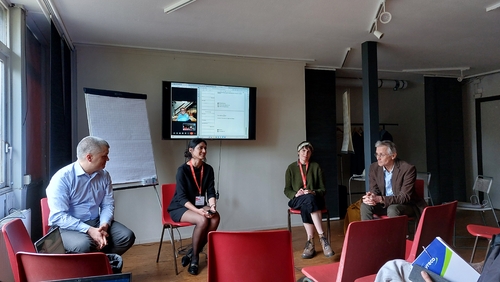The session particularly highlighted notions of creativity beyond the ones derived from the creative economy frameworks, conditions of our collective intelligence and judgements of creative outcomes.
Prof. Andrew Hudson-Smith sets the tone, saying that planners aren't used to let others get involved. Fundamentally, urban planning is about law. It is an institution of risk. Looking at the emerging oppertunities with AI, he askes: 'Is urban planning dead?' He sees things slowly moving.
Dr. Leah Lovett, from the Centre for Advanced Spatial Analysis, University College of London, is trained as a weaver. A craft which is very connected with cities. She says urban planning is slowly adapting new things. In reaction to creativity and new technologies she sees more interdisciplinairy groups emerging; with architects, urban planners, engineers etc. But, she says: 'It is important not being framed as an art project.' What she brings to the project is the critical creative thinking, bringing alternative lenses.
‘To be creative, one needs to embrace risk. In a collective process, there is the idea that we need to have a shared vision. While art is a verry individual process. Art can open up a space for connecting experience and knowledge.'
Dr. Johannes Flacke, from the Design and Interactive Space for Co-Creation lab-University of Twente, runs a lab where digital technologies are developed. These tools are made to give people a voice, bring them around the table and make the moment of interaction and exchange of ideas happen. The aim of the things they develop is to facilitate communication between different kinds of expertises, where the creativity comes along.
'The most important asset is trust. Impact is when people understand each another’s perspectives better.'
Dr. Bahador Bahrami, from the Crowd Cognition Lab - Ludwig Maximilian University of Munich, talks about collective intelligence and asks ‘What are we getting right and wrong about collective intelligence?’. One of the most important aspects, is that we always see the point of collective intelligence. We assume that decisions based on collective intelligence are better decisions. But what is it that collective intelligence achieves? Because doing things together is costly and takes a lot of effort. 'We noticed that the effort itself, doing things together, makes things less stressful.'
'The most important domain of where collective intelligence is most successful, is sharing responsibility. Particularly for urban planning and making decisions for the future about what seems to be right.'
His research has shown that collective intelligence can be used as a tool to protect the decisionmaker. This is the most important and useful system advantage for collective responsibility, and it has been missed out in the mainstream. Collective intelligence guarantees the outcome of with what will happen to you after a certain project. That’s the intelligence being useful in the long run. Of course, influence in the collective is not always positive; biases influence. The original idea is that collectives succeed when individuality, combining independent experience. Independent of opinions is key.
Prof. Oliver Alexy, from the School of Management – Technical University of Munich, gets asked by the moderator: 'How do you see the role of the collective working in urban planning?' Alexy responds: 'We’re striving to accurate foresight: Know now what’s right tomorrow. But we can’t. We know three things:
'First, we only know what we want, when we get it. We don’t know what we want until we see what is possible. Second, whatever structure you build, set up a process that’s relatively efficient. And third, who you have in the room will determine where the process goes. Being in charge of the agenda, being allowed to invite a certain person at a meeting is a form of power.'
He states it’s never about a collective, but always about vision from the top. It’s an organization that gives it direction. That’s systemic design; from power and performative perspective.
'In adopting design thinking in urban planning, what’s missing is the strategic decisions', Alexy says.. We do co-creation processes because it fééls nice. If you’re included everybody feels better, there’s a sensed feeling of justice. Perceptions of fairness is also important for the feeling that we made the best decisions. The likelihood for support for the decision goes up, but the likelihood on a coordinated outcome goes down.
So who should be in charge of the designing concept? The customer or the designer? You need to give the user limited space for decisions. And planning hasn’t solved the hindsight.
